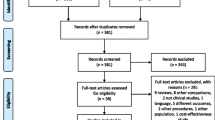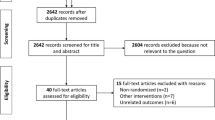Abstract
Introduction
Clean intermittent catheterization (CIC) is associated with an increased risk of urinary tract infections (UTI), urethral trauma, urethral stenosis, hematuria, and pain. The first catheters were developed of polyvinyl carbon (PVC). Several types of catheters have been developed to reduce these complications, such as those with hydrophilic coating.
Objective
To conduct a systematic review and meta-analysis to evaluate the effectiveness of hydrophilic coated catheters compared to uncoated catheters on the rate of UTI in patients using CIC.
Methodology
A systematic literature search was performed in OVID, Embase, Scopus, Web of Science, PubMed, and CENTRAL databases. Randomized controlled trials (RCTs) or randomized crossover trials comparing UTI and hematuria rates in patients using hydrophilic vs. non-hydrophilic catheters for CIC were identified. The selected trials were evaluated for risk of bias using the “Revised Cochrane risk-of-bias tool for randomized trials (RoB 2).” The results were expressed as a risk ratio (RR) with a 95% confidence interval (CI), under a random-effects model. Data were analyzed using Review Manager 5.4 software.
Results
Nine studies with a total of 525 patients in CIC were analyzed. Overall, the use of hydrophilic catheters had a lower risk of UTIs compared to uncoated catheters (RR = 0.78; 95% CI 0.62–0.97; I2 = 37%). Five of the studies include patients > 18 years, showing a reduction of UTIs with the use of hydrophilic catheters (RR = 0.83; 95% CI 0.74–0.93; I2 = 0%). There was no difference in UTI development when comparing single-use uncoated vs hydrophilic catheters. However, heterogeneity was high (RR = 0.77; 95% CI 0.59–1.00; I2 = 57%). Regarding hematuria risk reduction, we were unable to identify differences between the use of hydrophilic catheters compared to uncoated catheters (RR = 1.02; 95% CI 0.66–1.60).
Conclusion
We found a risk reduction of UTIs associated with using hydrophilic catheters in adults, with low heterogeneity. Regarding hematuria, significant differences were not proved. We do not find a significant difference in UTI risk reduction in the pediatric population. Urethral trauma presence could not be meta‐analyzed due to a lack of information reported.



Similar content being viewed by others
Data availability statement
The data that support the findings of this study are available from the corresponding author upon reasonable request.
References
Abrams P, Andersson KE, Apostolidis A, et al (2018) 6th International Consultation on Incontinence. Recommendations of the International Scientific Committee: evaluation and treatment of urinary incontinence, pelvic organ prolapse and faecal incontinence. Neurourol Urodyn 37(7):2271–2272. https://doi.org/10.1002/nau.23551
Chaikin DC, Blaivas JG (2001) Voiding dysfunction: definitions. Curr Opin Urol 11(4):395–398. https://doi.org/10.1097/00042307-200107000-00010
Lamin E, Newman DK (2016) Clean intermittent catheterization revisited. Int Urol Nephrol 48(6):931–939. https://doi.org/10.1007/s11255-016-1236-9
Panicker JN, Fowler CJ, Kessler TM (2015) Lower urinary tract dysfunction in the neurological patient: clinical assessment and management. Lancet Neurol 14(7):720–732. https://doi.org/10.1016/S1474-4422(15)00070-8
Engberg S, Clapper J, McNichol L, Thompson D, Welch VW, Gray M (2020) Current evidence related to intermittent catheterization. J Wound Ostomy Continence Nurs 47(2):140–165. https://doi.org/10.1097/WON.0000000000000625
Lauridsen S, Cobussen-Boekhorst H, Eikenboom J, et al (2013) European Association of Urology Nurses Evidence-Based Guidelines for Best Practice in Urological Health Care Catheterisation Urethral Intermittent in Adults Dilatation, Urethral Intermittent in Adults Evidence-Based Guidelines for Best Practice in Urological Health Care Catheterisation Urethral Intermittent in Adults Dilatation, Urethral Intermittent in Adults
Wyndaele JJ, Brauner A, Geerlings SE, Bela K, Peter T, Bjerklund-Johanson TE (2012) Clean intermittent catheterization and urinary tract infection: review and guide for future research. BJU Int 110(11c):E910–E917. https://doi.org/10.1111/j.1464-410X.2012.11549.x
Stensballe J, Looms D, Nielsen PN, Tvede M (2005) Hydrophilic-coated catheters for intermittent catheterisation reduce urethral micro trauma: a prospective, randomised, participant-blinded, crossover study of three different types of catheters. Eur Urol 48(6):978–983. https://doi.org/10.1016/j.eururo.2005.07.009
DeFoor W, Reddy P, Reed M et al (2017) Results of a prospective randomized control trial comparing hydrophilic to uncoated catheters in children with neurogenic bladder. J Pediatr Urol 13(4):373.e1-373.e5. https://doi.org/10.1016/j.jpurol.2017.06.003
Sutherland RS, Kogan BA, Baskin LS, Mevorach RA (1996) Clean intermittent catheterization in boys using the Lofric catheter. J urology 156(6):2041–2043. https://doi.org/10.1016/S0022-5347(01)65430-2
Pachler J, Frimodt-Møller C (1999) A comparison of prelubricated hydrophilic and non-hydrophilic polyvinyl chloride catheters for urethral catheterization. BJU Int 83(7):767–769. https://doi.org/10.1046/j.1464-410x.1999.00013.x
Cardenas DD, Moore KN, Dannels-McClure A et al (2011) Intermittent catheterization with a hydrophilic-coated catheter delays urinary tract infections in acute spinal cord injury: a prospective, randomized multicenter trial. PM&R 3(5):408–417. https://doi.org/10.1016/j.pmrj.2011.01.001
Sarica S, Akkoc Y, Karapolat H, Aktug H (2010) Comparison of the use of conventional, hydrophilic and gel-lubricated catheters with regard to urethral micro trauma, urinary system infection, and patient satisfaction in patients with spinal cord injury: a randomized controlled study. Eur J Phys Rehabil Med 46(4):473–479
de Ridder DJMK, Everaert K, Fernández LG et al (2005) Intermittent catheterisation with hydrophilic-coated catheters (SpeediCath) reduces the risk of clinical urinary tract infection in spinal cord injured patients: a prospective randomised parallel comparative trial. Eur Urol 48(6):991–995. https://doi.org/10.1016/j.eururo.2005.07.018
Cardenas DD, Hoffman JM (2009) Hydrophilic catheters versus noncoated catheters for reducing the incidence of urinary tract infections: a randomized controlled trial. Arch Phys Med Rehabil 90(10):1668–1671. https://doi.org/10.1016/j.apmr.2009.04.010
Massa LM, Hoffman JM, Cardenas DD (2009) Validity, accuracy, and predictive value of urinary tract infection signs and symptoms in individuals with spinal cord injury on intermittent catheterization. J Spinal Cord Med 32(5):568–573. https://doi.org/10.1080/10790268.2009.11754562
Vapnek JM, Maynard FM, Kim J (2003) A prospective randomized trial of the lofric hydrophilic coated catheter versus conventional plastic catheter for clean intermittent catheterization. J Urol 169(3):994–998. https://doi.org/10.1097/01.ju.0000051160.72187.e9
Ginsberg DA, Boone TB, Cameron AP et al (2021) The AUA/SUFU guideline on adult neurogenic lower urinary tract dysfunction: treatment and follow-up. J Urol 206(5):1106–1113. https://doi.org/10.1097/JU.0000000000002239
Tornic J, Wöllner J, Leitner L, Mehnert U, Bachmann LM, Kessler TM (2020) The challenge of asymptomatic bacteriuria and symptomatic urinary tract infections in patients with neurogenic lower urinary tract dysfunction. J Urol 203(3):579–584. https://doi.org/10.1097/JU.0000000000000555
Hooton TM, Bradley SF, Cardenas DD et al (2010) Diagnosis, prevention, and treatment of catheter-associated urinary tract infection in adults: 2009 International Clinical Practice Guidelines from the Infectious Diseases Society of America. Clin Infect Dis 50(5):625–663. https://doi.org/10.1086/650482
Moore KN, Fader M, Getliffe K (2007) Long-term bladder management by intermittent catheterisation in adults and children. In: Moore KN (ed) Cochrane database of systematic reviews. Wiley. https://doi.org/10.1002/14651858.CD006008.pub2
Bermingham SL, Hodgkinson S, Wright S, Hayter E, Spinks J, Pellowe C (2013) Intermittent self catheterisation with hydrophilic, gel reservoir, and non-coated catheters: a systematic review and cost effectiveness analysis. BMJ 346(jan08 15):e8639. https://doi.org/10.1136/bmj.e8639
Rognoni C, Tarricone R (2017) Intermittent catheterisation with hydrophilic and non-hydrophilic urinary catheters: systematic literature review and meta-analyses. BMC Urol 17(1):4. https://doi.org/10.1186/s12894-016-0191-1
Li L, Ye W, Ruan H, Yang B, Zhang S, Li L (2013) Impact of hydrophilic catheters on urinary tract infections in people with spinal cord injury: systematic review and meta-analysis of randomized controlled trials. Arch Phys Med Rehabil 94(4):782–787. https://doi.org/10.1016/j.apmr.2012.11.010
Higgins JPT, Thomas J, Chandler J, Cumpston M, Li T, Page MJ, Welch VA (2019) Cochrane Handbook for Systematic Reviews of Interventions. 2nd Edition. John Wiley & Sons, Chichester (UK)
Prieto J, Murphy CL, Moore KN, Fader M (2014) Intermittent catheterisation for long-term bladder management. In M. Fader (Ed.), Cochrane Database of Systematic Reviews. John Wiley & Sons, Ltd. https://doi.org/10.1002/14651858.CD006008.pub3
Funding
Private funding for research was obtained as an independent research initiative, granted by Coloplast.
Author information
Authors and Affiliations
Contributions
MP and JS contributed to protocol/project development. MP, JS, and CT were involved in data collection or management. SV and JS contributed to data analysis. JA, LZ, CT, MP, and JS were involved in manuscript writing/editing.
Corresponding author
Ethics declarations
Conflict of interest
The authors declare not to have a potential conflict of interest.
Ethics statement
The research protocol is in accordance with the ethical standards of the Institutional Ethics Committee at Hospital Universitario Fundación Santa Fe de Bogotá and with the 1964 Helsinki Declaration.
Research involving human participants and/or animals
Not applicable.
Informed consent
Not applicable.
Additional information
Publisher's Note
Springer Nature remains neutral with regard to jurisdictional claims in published maps and institutional affiliations.
Supplementary Information
Below is the link to the electronic supplementary material.
Rights and permissions
Springer Nature or its licensor (e.g. a society or other partner) holds exclusive rights to this article under a publishing agreement with the author(s) or other rightsholder(s); author self-archiving of the accepted manuscript version of this article is solely governed by the terms of such publishing agreement and applicable law.
About this article
Cite this article
Plata, M., Santander, J., Zuluaga, L. et al. Hydrophilic versus non-hydrophilic catheters for clean intermittent catheterization: a meta-analysis to determine their capacity in reducing urinary tract infections. World J Urol 41, 491–499 (2023). https://doi.org/10.1007/s00345-022-04235-5
Received:
Accepted:
Published:
Issue Date:
DOI: https://doi.org/10.1007/s00345-022-04235-5




